Spiral-Resonator-Based Frequency Reconfigurable Antenna Design for Sub-6 GHz Applications
Abstract
1. Introduction
2. Antenna Design
2.1. Simulated Design
2.2. Parametric Analysis and Equivalent Circuit
2.2.1. Parametric Analysis
2.2.2. Equivalent Circuit Model
2.3. Fabricated Designs
3. Results and Discussions
3.1. Simulation Results
3.2. Measurement Results
4. Conclusions
Author Contributions
Funding
Data Availability Statement
Acknowledgments
Conflicts of Interest
References
- Yusifov, S.I.; Ragimova, N.A.; Abdullayev, V.H.; Imanova, Z.B. 5G Technology: A New Step to IoT Platform. JINAV J. Inf. Vis. 2020, 1, 74–82. [Google Scholar] [CrossRef]
- West, D.M. How 5G technology enables the health internet of things. Brook. Cent. Technol. Innov. 2016, 3, 20. [Google Scholar]
- Li, S.; Da Xu, L.; Zhao, S. 5G Internet of Things: A survey. J. Ind. Inf. Integr. 2018, 10, 1–9. [Google Scholar] [CrossRef]
- Andrews, J.G.; Buzzi, S.; Choi, W.; Hanly, S.V.; Lozano, A.; Soong, A.C.; Zhang, J.C. What will 5G be? IEEE J. Sel. Areas Commun. 2014, 32, 1065–1082. [Google Scholar] [CrossRef]
- Goudos, S.K.; Dallas, P.I.; Chatziefthymiou, S.; Kyriazakos, S. A survey of IoT key enabling and future technologies: 5G, mobile IoT, sematic web and applications. Wirel. Pers. Commun. 2017, 97, 1645–1675. [Google Scholar] [CrossRef]
- Güneş, F.; Evranos, İ.Ö.; Belen, M.A.; Mahouti, P.; Palandöken, M. A compact triband antipodal vivaldi antenna with frequency selective surface inspired director for IoT/WLAN applications. Wirel. Netw. 2021, 27, 3195–3205. [Google Scholar] [CrossRef]
- Mohammed, A.S.; Kamal, S.; Ain, M.F.B.; Hussin, R.; Najmi, F.; Sundi, S.A.; Othman, M. Mathematical model on the effects of conductor thickness on the centre frequency at 28 GHz for the performance of microstrip patch antenna using air substrate for 5G application. Alex. Eng. J. 2021, 60, 5265–5273. [Google Scholar] [CrossRef]
- Iqbal, J.; Illahi, U.; Yasin, M.N.M.; Albreem, M.A.; Akbar, M.F. Bandwidth enhancement by using parasitic patch on dielectric resonator antenna for sub-6 GHz 5G NR bands application. Alex. Eng. J. 2022, 61, 5021–5032. [Google Scholar] [CrossRef]
- Shereen, M.K.; Khattak, M.I.; Nebhen, J. A review of achieving frequency reconfiguration through switching in microstrip patch antennas for future 5G applications. Alex. Eng. J. 2022, 61, 29–40. [Google Scholar] [CrossRef]
- Kamal, S.; Ain, M.F.B.; Ullah, U.; Mohammed, A.S.; Najmi, F.; Hussin, R.; Othman, M. Wheel-shaped miniature assembly of circularly polarized wideband microstrip antenna for 5G mmWave terminals. Alex. Eng. J. 2021, 60, 2457–2470. [Google Scholar] [CrossRef]
- Kumar, S.A.; Shanmuganantham, T.; Dileepan, D. Design and development of CPW fed monopole antenna at 2.45 GHz and 5.5 GHz for wireless applications. Alex. Eng. J. 2017, 56, 231–234. [Google Scholar] [CrossRef]
- Nashaat, D.M.; Elsadek, H.A.; Ghali, H. Single feed compact quad-band PIFA antenna for wireless communication applications. IEEE Trans. Antennas Propag. 2005, 53, 2631–2635. [Google Scholar] [CrossRef]
- Karli, R.; Ammor, H. A simple and original design of multi-band microstrip patch antenna for wireless communication. Int. J. Microw. Appl. 2013, 2, 41–44. [Google Scholar]
- Zhu, X.Q.; Guo, Y.X.; Wu, W. A novel dual-band antenna for wireless communication applications. IEEE Antennas Wirel. Propag. Lett. 2015, 15, 516–519. [Google Scholar] [CrossRef]
- Sun, L.; He, M.; Hu, J.; Zhu, Y.; Chen, H. A butterfly-shaped wideband microstrip patch antenna for wireless communication. Int. J. Antennas Propag. 2015, 2015, 328208. [Google Scholar] [CrossRef]
- Schaubert, D.H.; Farrar, F.G.; Hayes, S.T.; Sindoris, A.R.; Department Of the Army Washington DC. Frequency-Agile, Polarization Diverse Microstrip Antennas and Frequency Scanned Arrays. U.S. Patent 4367474, 1 April 1983. [Google Scholar]
- Ullah, S.; Ahmad, S.; Khan, B.A.; Tahir, F.A.; Flint, J.A. An hp-shape hexa-band antenna for multi-standard wireless communication systems. Wirel. Netw. 2019, 25, 1361–1369. [Google Scholar] [CrossRef]
- Vamseekrishna, A.; Madhav, B.T.P.; Anilkumar, T.; Reddy, L.S.S. An IoT controlled octahedron frequency reconfigurable multiband antenna for microwave sensing applications. IEEE Sens. Lett. 2019, 3, 3502204. [Google Scholar] [CrossRef]
- Zhao, X.; Riaz, S. A dual-band frequency reconfigurable MIMO patch-slot antenna based on reconfigurable microstrip feedline. IEEE Access 2018, 6, 41450–41457. [Google Scholar] [CrossRef]
- Han, L.; Wang, C.; Chen, X.; Zhang, W. Compact frequency-reconfigurable slot antenna for wireless applications. IEEE Antennas Wirel. Propag. Lett. 2016, 15, 1795–1798. [Google Scholar] [CrossRef]
- Arun, V.; Marx, L.K. Internet of Things controlled reconfigurable antenna for RF harvesting. Def. Sci. J. 2018, 68, 566–571. [Google Scholar]
- Zaidi, A.; Awan, W.A.; Hussain, N.; Baghdad, A. A Wide and Tri-band Flexible Antennas with Independently Controllable Notch Bands for Sub-6-GHz Communication System. Radioengineering 2020, 29, 44–51. [Google Scholar] [CrossRef]
- Cai, Y.M.; Li, K.; Yin, Y.; Gao, S.; Hu, W.; Zhao, L. A low-profile frequency reconfigurable grid-slotted patch antenna. IEEE Access 2018, 6, 36305–36312. [Google Scholar] [CrossRef]
- Allam, V.K.; Madhav, B.T.; Anilkumar, T.; Maloji, S. A novel reconfigurable bandpass filtering antenna for IoT communication applications. Prog. Electromagn. Res. C 2019, 96, 13–26. [Google Scholar] [CrossRef]
- Soltanpour, M.; Fakharian, M.M. Compact filtering slot antenna with frequency agility for Wi-Fi/LTE mobile applications. Electron. Lett. 2016, 52, 491–492. [Google Scholar] [CrossRef]
- Abdulraheem, Y.I.; Oguntala, G.A.; Abdullah, A.S.; Mohammed, H.J.; Ali, R.A.; Abd-Alhameed, R.A.; Noras, J.M. Design of frequency reconfigurable multiband compact antenna using two PIN diodes for WLAN/WiMAX applications. IET Microw. Antennas Propag. 2017, 11, 1098–1105. [Google Scholar] [CrossRef]
- Ali, T.; Khaleeq, M.M.; Biradar, R.C. A multiband reconfigurable slot antenna for wireless applications. AEU-International J. Electron. Commun. 2018, 84, 273–280. [Google Scholar] [CrossRef]
- Ghaffar, A.; Li, X.J.; Awan, W.A.; Iffat Naqvi, S.; Hussain, N.; Seet, B.C.; Limiti, E. Design and realization of a frequency reconfigurable multimode antenna for ISM, 5G-sub-6-GHz, and S-band applications. Appl. Sci. 2021, 11, 1635. [Google Scholar] [CrossRef]
- Koc Polat, H.; Geyikoglu, M.D.; Cavusoglu, B. Modeling and validation of a new reconfigurable patch antenna through equivalent lumped circuit-based design for minimum tuning effort. Microw. Opt. Technol. Lett. 2020, 62, 2335–2345. [Google Scholar] [CrossRef]
- Shah, I.A.; Hayat, S.; Basir, A.; Zada, M.; Shah, S.A.A.; Ullah, S. Design and analysis of a hexa-band frequency reconfigurable antenna for wireless communication. AEU-Int. J. Electron. Commun. 2019, 98, 80–88. [Google Scholar] [CrossRef]
- Suzdalenko, A.; Chub, A. Current sensorless control for half-bridge-based AC/DC PFC converter with consideration of conduction losses. Int. J. Circuit Theory Appl. 2016, 44, 2072–2084. [Google Scholar] [CrossRef]
- Zhang, S.; Huff, G.H.; Feng, J.; Bernhard, J.T. A pattern reconfigurable microstrip parasitic array. IEEE Trans. Antennas Propag. 2004, 52, 2773–2776. [Google Scholar] [CrossRef]
- Trinh, L.H.; Le, T.N.; Staraj, R.; Ferrero, F.; Lizzi, L. A pattern-reconfigurable slot antenna for IoT network concentrators. Electronics 2017, 6, 105. [Google Scholar] [CrossRef]
- Costantine, J.; Kanj, R.; Ghorayeb, Z.; Al Bahar, T.; Itani, Y.; Tawk, Y.; Christodoulou, C.G. A radiation pattern reconfigurable antenna for WLAN access. In Proceedings of the 2016 United States National Committee of URSI National Radio Science Meeting (USNC-URSI NRSM), Boulder, CO, USA, 6–9 January 2016; pp. 1–2. [Google Scholar]
- Cheung, S.W.; Zhou, C.F.; Li, Q.L.; Yuk, T.I. A simple polarization-reconfigurable antenna. In Proceedings of the 2016 10th European Conference on Antennas and Propagation (EuCAP), Davos, Switzerland, 10–15 April 2016; pp. 1–4. [Google Scholar]
- Al-Yasir, Y.I.; Abdullah, A.S.; Ojaroudi Parchin, N.; Abd-Alhameed, R.A.; Noras, J.M. A new polarization-reconfigurable antenna for 5G applications. Electronics 2018, 7, 293. [Google Scholar] [CrossRef]
- Ni, C.; Liu, C.; Zhang, Z.; Chen, M.; Zhang, L.; Wu, X. Design of Broadband High Gain Polarization Reconfigurable Fabry-Perot Cavity Antenna Using Metasurface. Front. Phys. 2020, 8, 316. [Google Scholar] [CrossRef]
- Saravanan, M.; Rangachar, M.J.S. Polarization reconfigurable square patch antenna for wireless communications. Adv. Electromagn. 2018, 7, 103–108. [Google Scholar] [CrossRef]
- Iqbal, A.; Smida, A.; Mallat, N.K.; Ghayoula, R.; Elfergani, I.; Rodriguez, J.; Kim, S. Frequency and pattern reconfigurable antenna for emerging wireless communication systems. Electronics 2019, 8, 407. [Google Scholar]
- Lakshmi, M.L.S.N.S.; Madhav, B.T.P.; Khan, H.; Kishore, P.V.V. A frequency and pattern reconfigurable asymmetric ground antenna on flexible polyimide material for LTE, Wi-Fi, WLAN and fixed satellite applications. Flex. Print. Electron. 2020, 5, 025007. [Google Scholar] [CrossRef]
- Ojaroudi Parchin, N.; Jahanbakhsh Basherlou, H.; Al-Yasir, Y.I.; Abdulkhaleq, A.M.; Abd-Alhameed, R.A. Reconfigurable antennas: Switching techniques—A survey. Electronics 2020, 9, 336. [Google Scholar] [CrossRef]
- Chen, Z.N.; Liu, D.; Nakano, H.; Qing, X.; Zwick, T. Handbook of Antenna Technologies. Springer Nature Singapore: Gateway East, Singapore, 2016. [Google Scholar]
- Sreelekshmi, S.; Sankar, S.P. A square ring and single split resonator based wearable antenna for Microwave energy harvesting for IoT nodes. Sustain. Energy Technol. Assess. 2022, 52, 102217. [Google Scholar] [CrossRef]
- Li, Y.; Feng, Q. A compact tri-band monopole antenna with metamaterial loaded for WLAN/WiMAX applications. J. Electromagn. Waves Appl. 2013, 27, 772–782. [Google Scholar] [CrossRef]
- Chen, X.; Chen, J.; Liu, C.; Huang, K. A genetic metamaterial and its application to gain improvement of a patch antenna. J. Electromagn. Waves Appl. 2012, 26, 1977–1985. [Google Scholar] [CrossRef]
- Kumar, N.; Gupta, S.C. Analyzing the performance of a microstrip patch antenna with metamaterial cover by varying the distance and dielectric constant in between. J. Electromagn. Waves Appl. 2015, 29, 2428–2443. [Google Scholar] [CrossRef]
- Hussain, A.; Dong, J.; Abdulkarim, Y.I.; Wu, R.; Muhammadsharif, F.F.; Shi, R.; Howlader, M.M.R. A double negative (DNG) metamaterial based on parallel double-E square split resonators for multi-band applications: Simulation and experiment. Results Phys. 2023, 46, 106302. [Google Scholar] [CrossRef]
- Banerjee, S.; Dutta, P.; Basu, S.; Mishra, S.K.; Appasani, B.; Nanda, S.; Thounthong, P. A New Design of a Terahertz Metamaterial Absorber for Gas Sensing Applications. Symmetry 2023, 15, 24. [Google Scholar] [CrossRef]
- Balanis, C.A. Antenna Theory: Analysis and Design; John Wiley & Sons: Hoboken, NJ, USA, 2016. [Google Scholar]
- Bahl, I.J. A designer’s guide to microstrip line. Microwaves 1977, 16, 174–182. [Google Scholar]
- California Eastern Laboratories. L, S-Band High Power SPDT RF Switch CG2415M6 Datasheet. Available online: https://www.cel.com/documents/datasheets/CG2415M6.pdf (accessed on 1 September 2017).

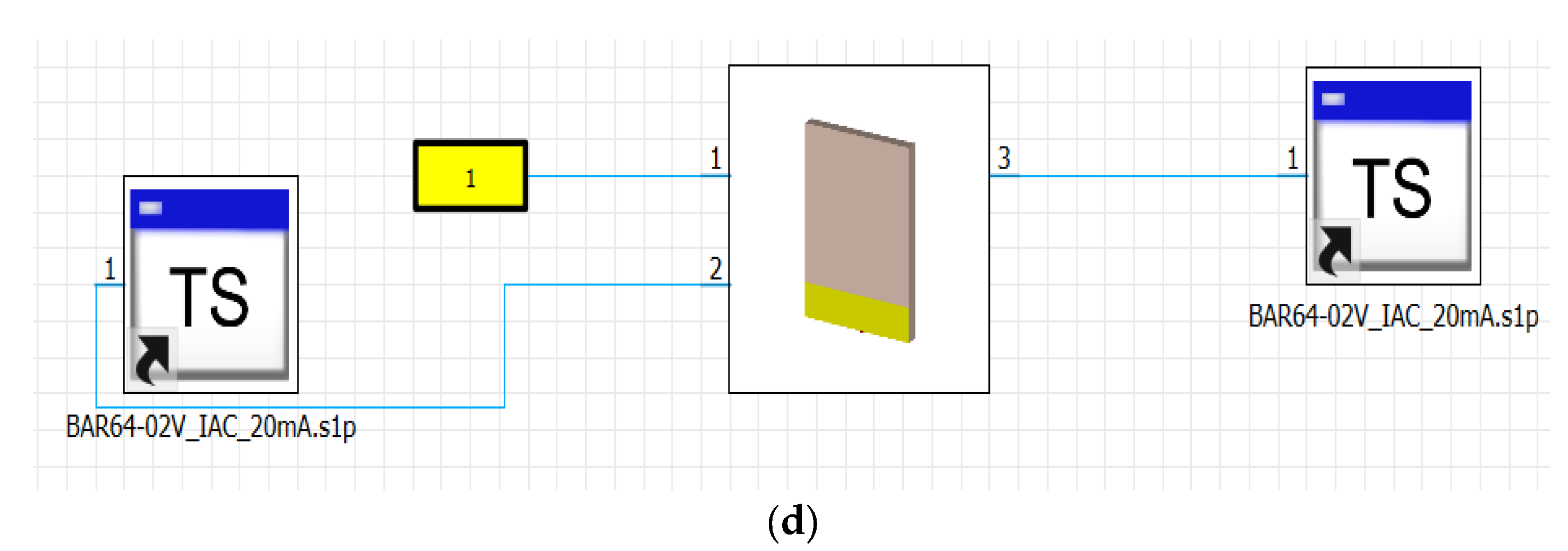

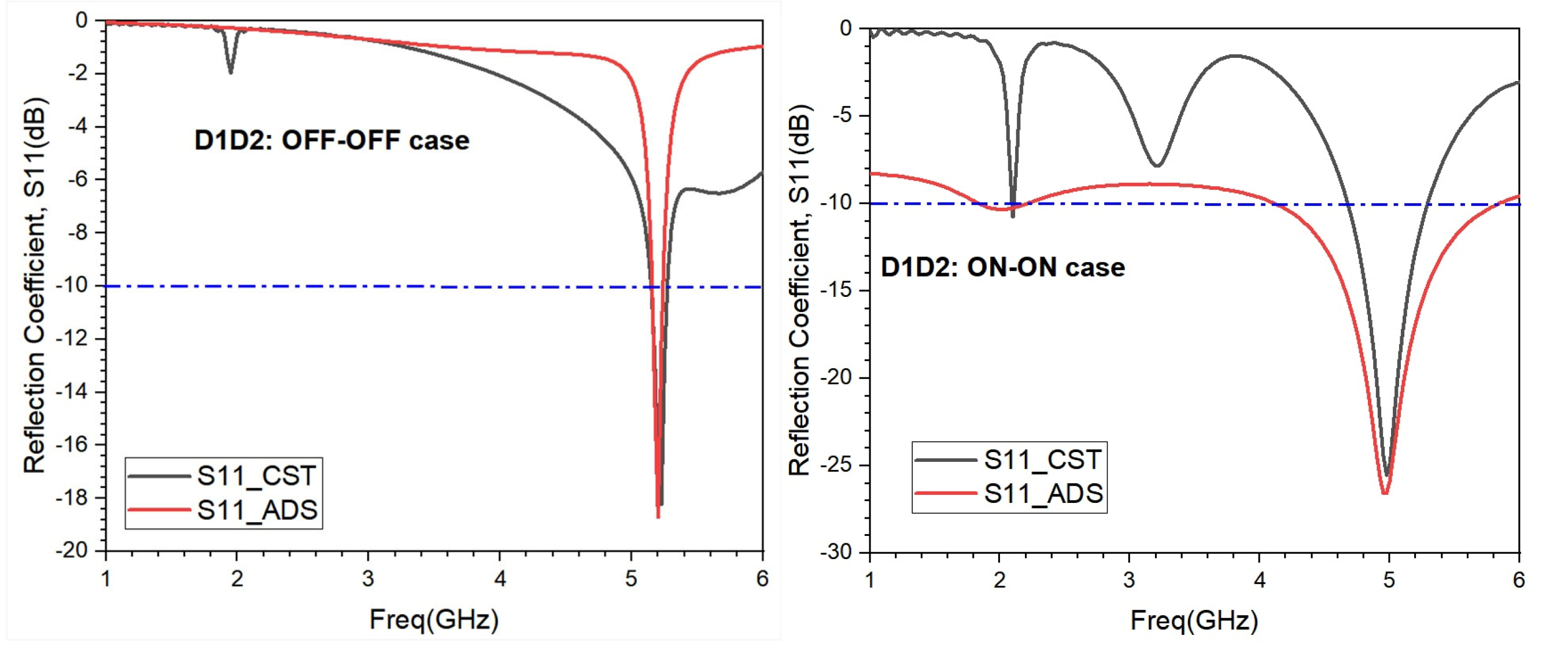
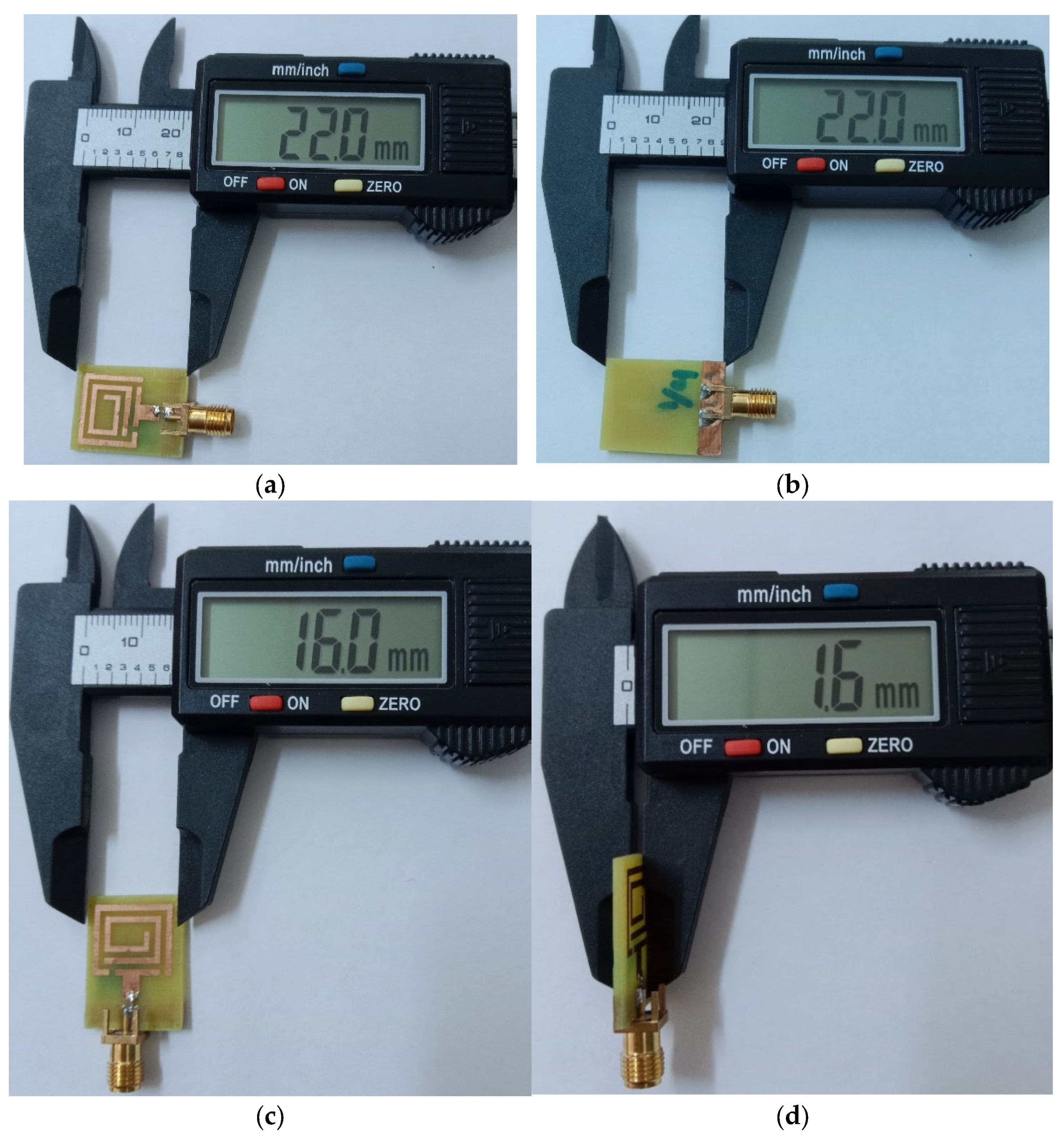
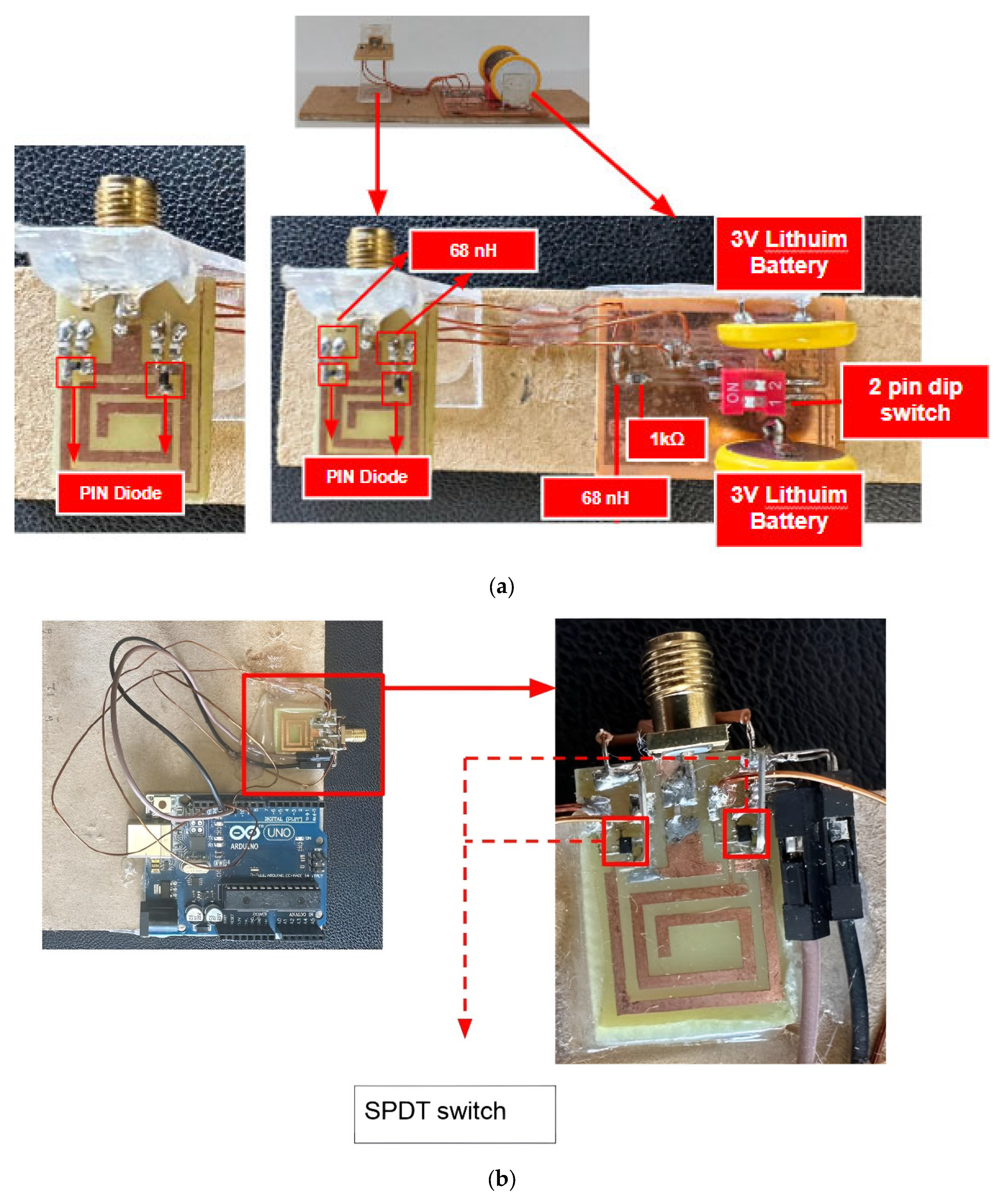
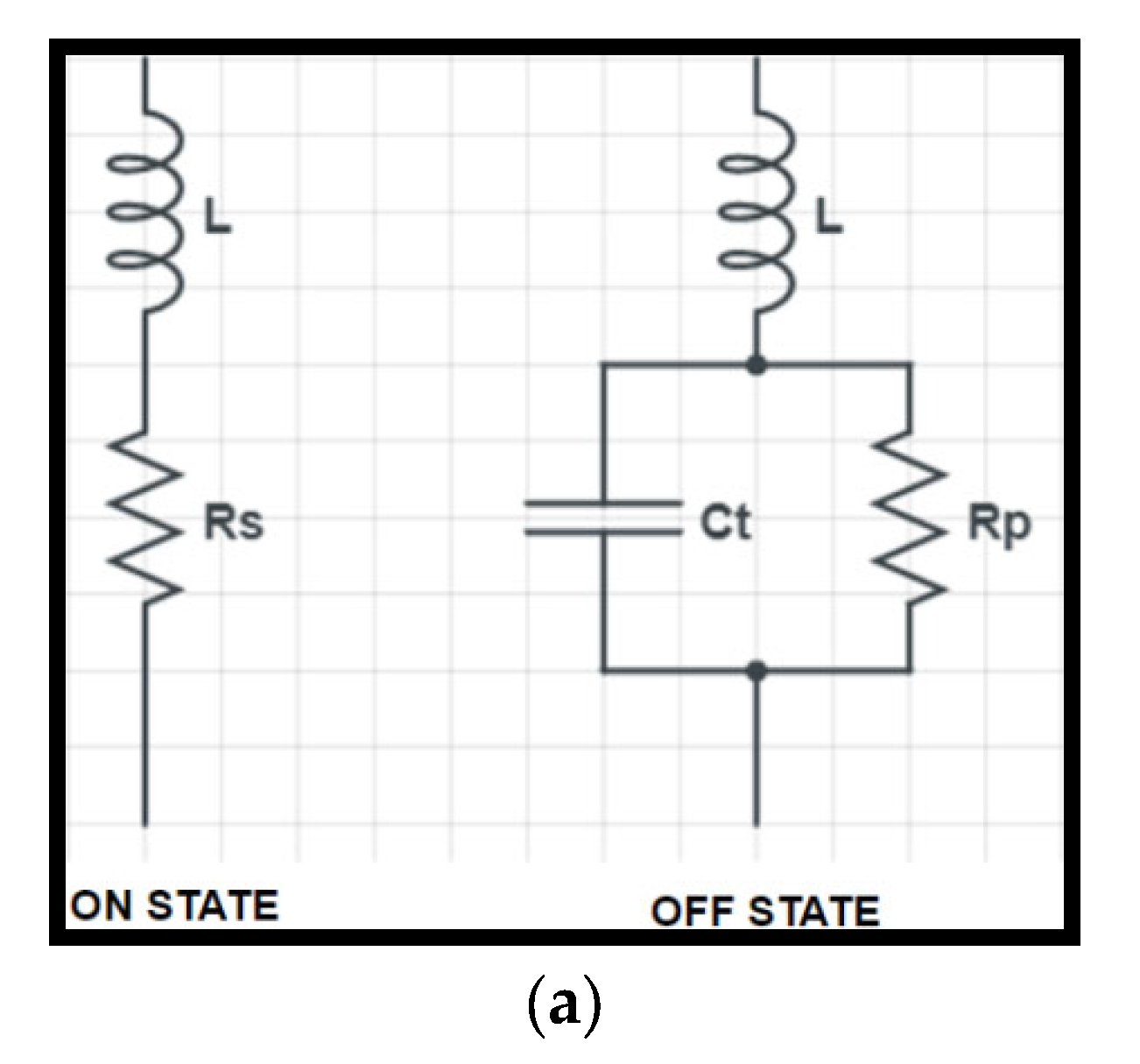
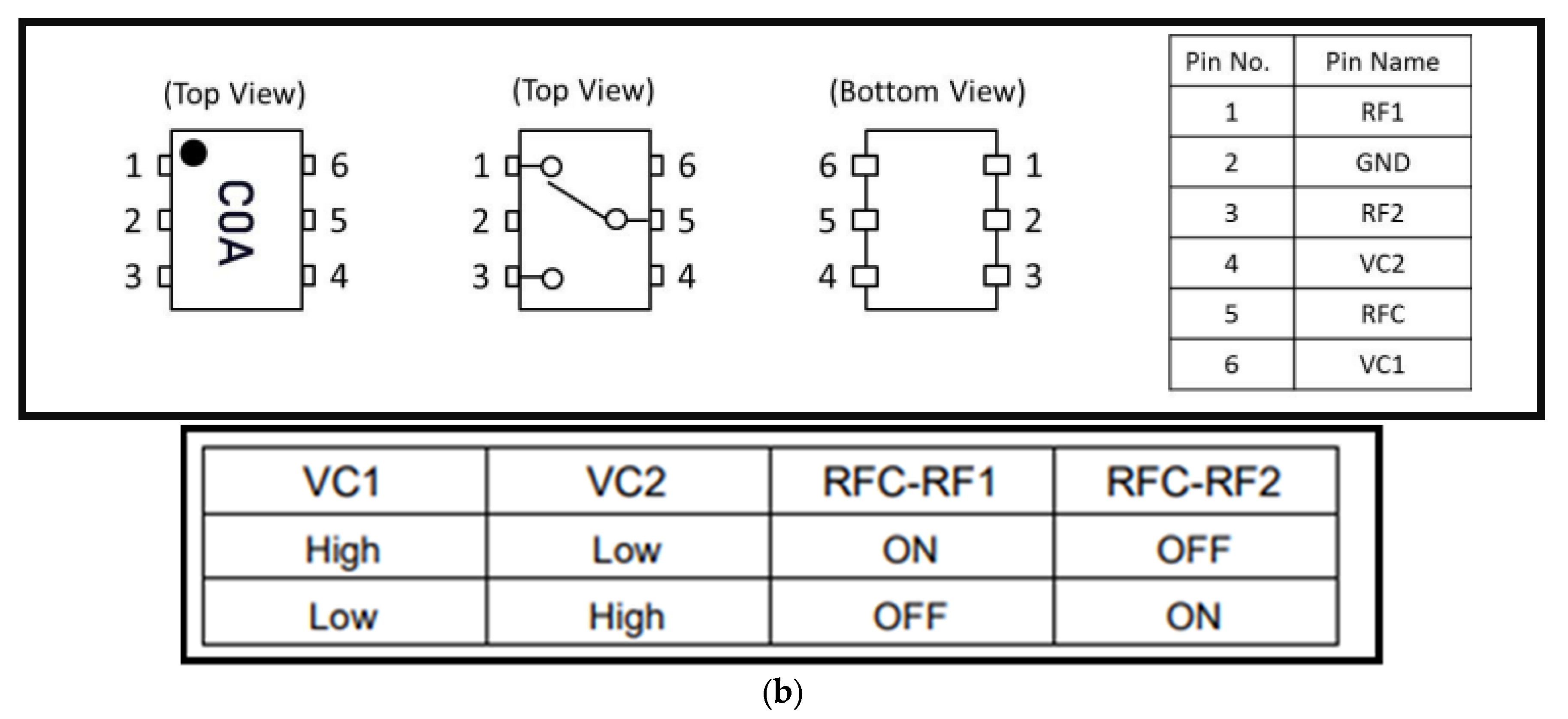
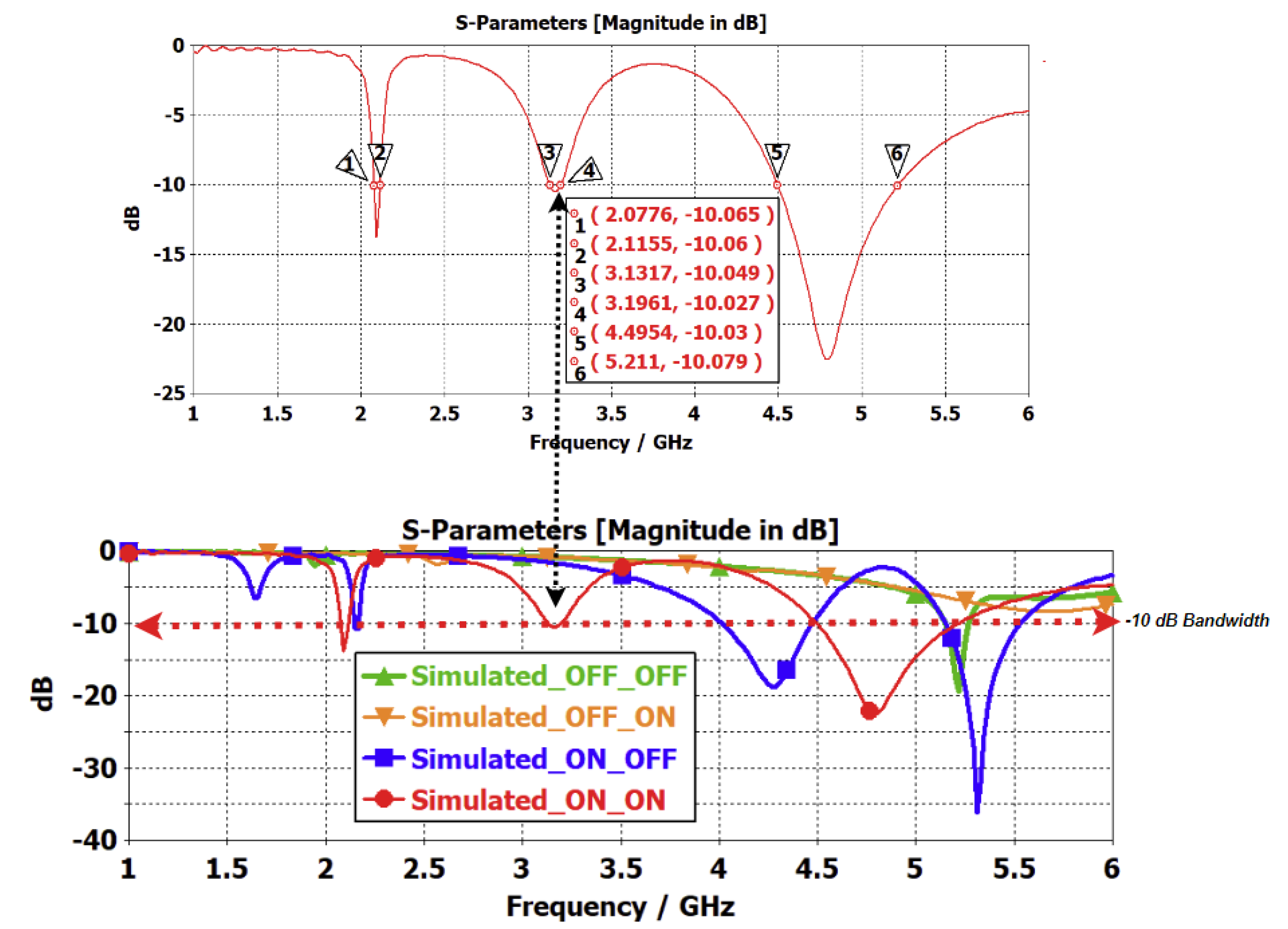
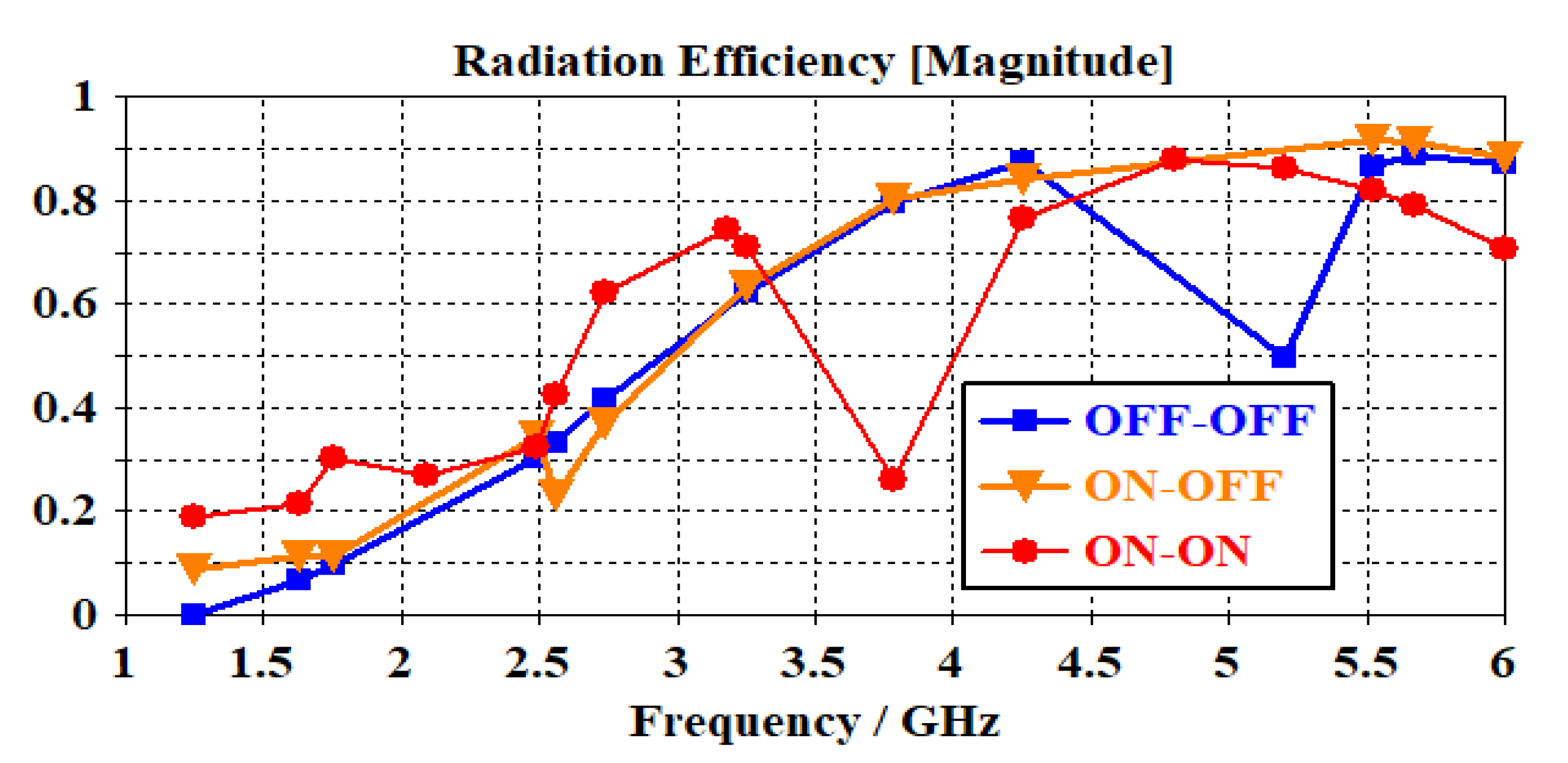
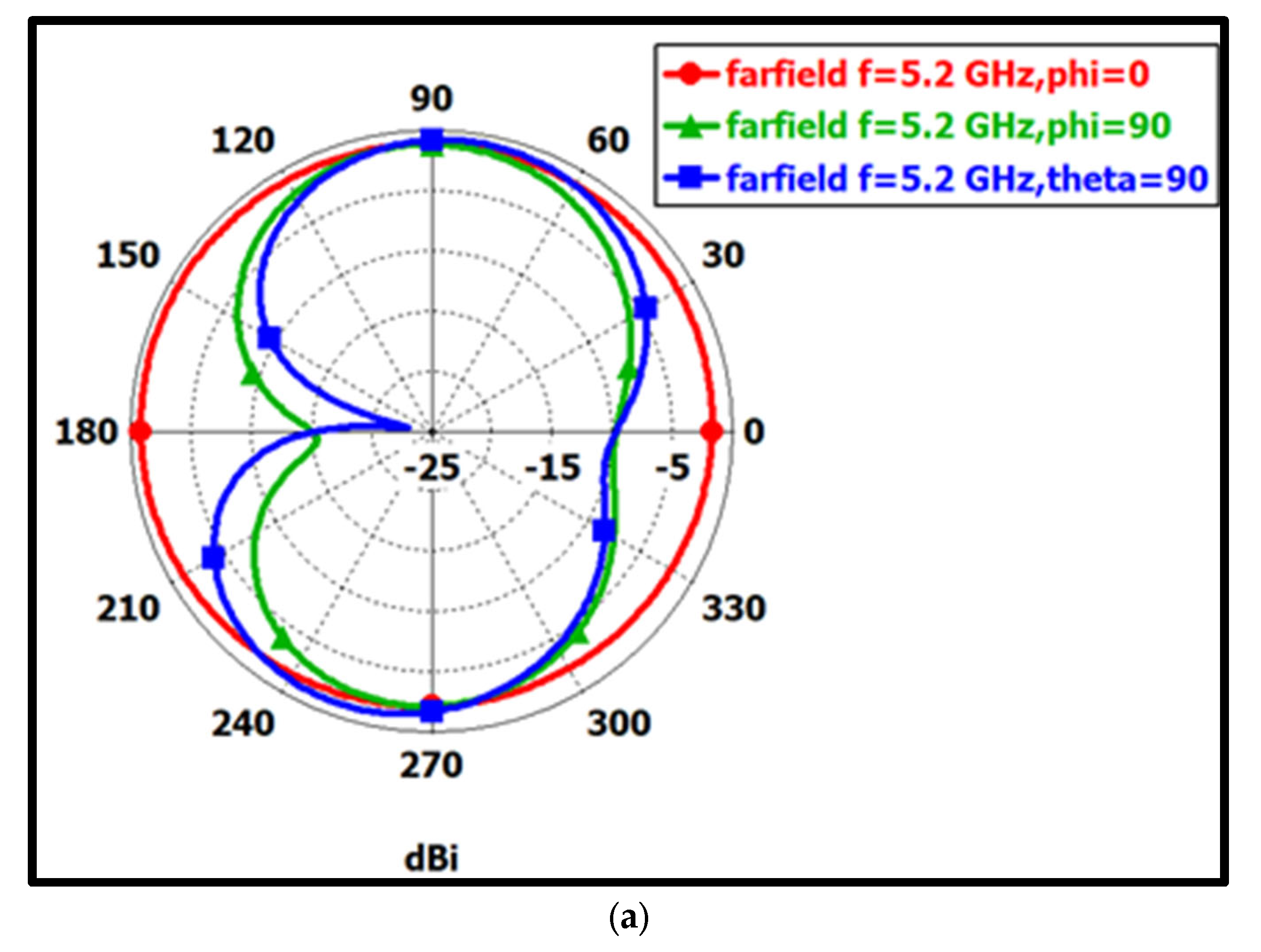
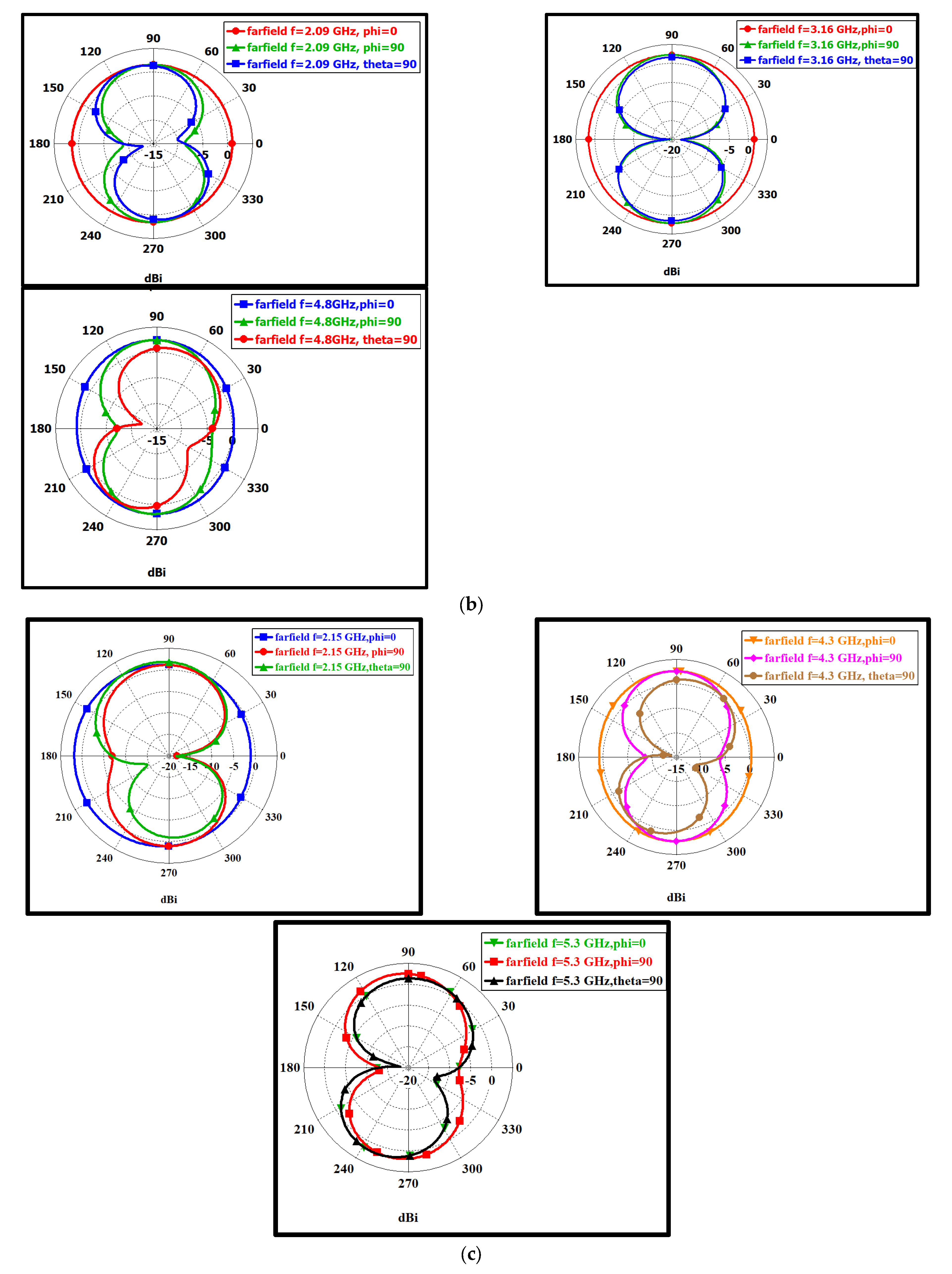
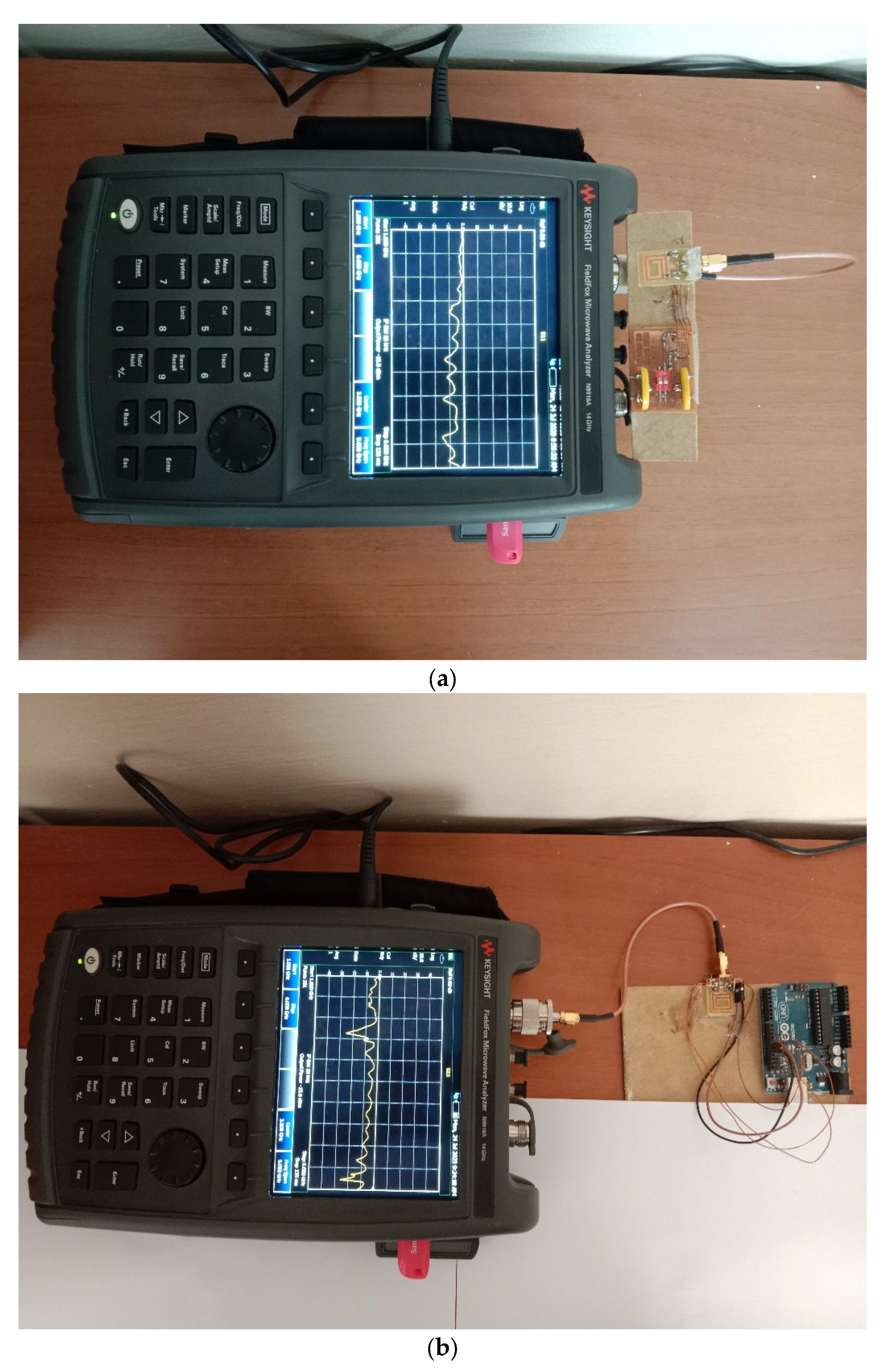

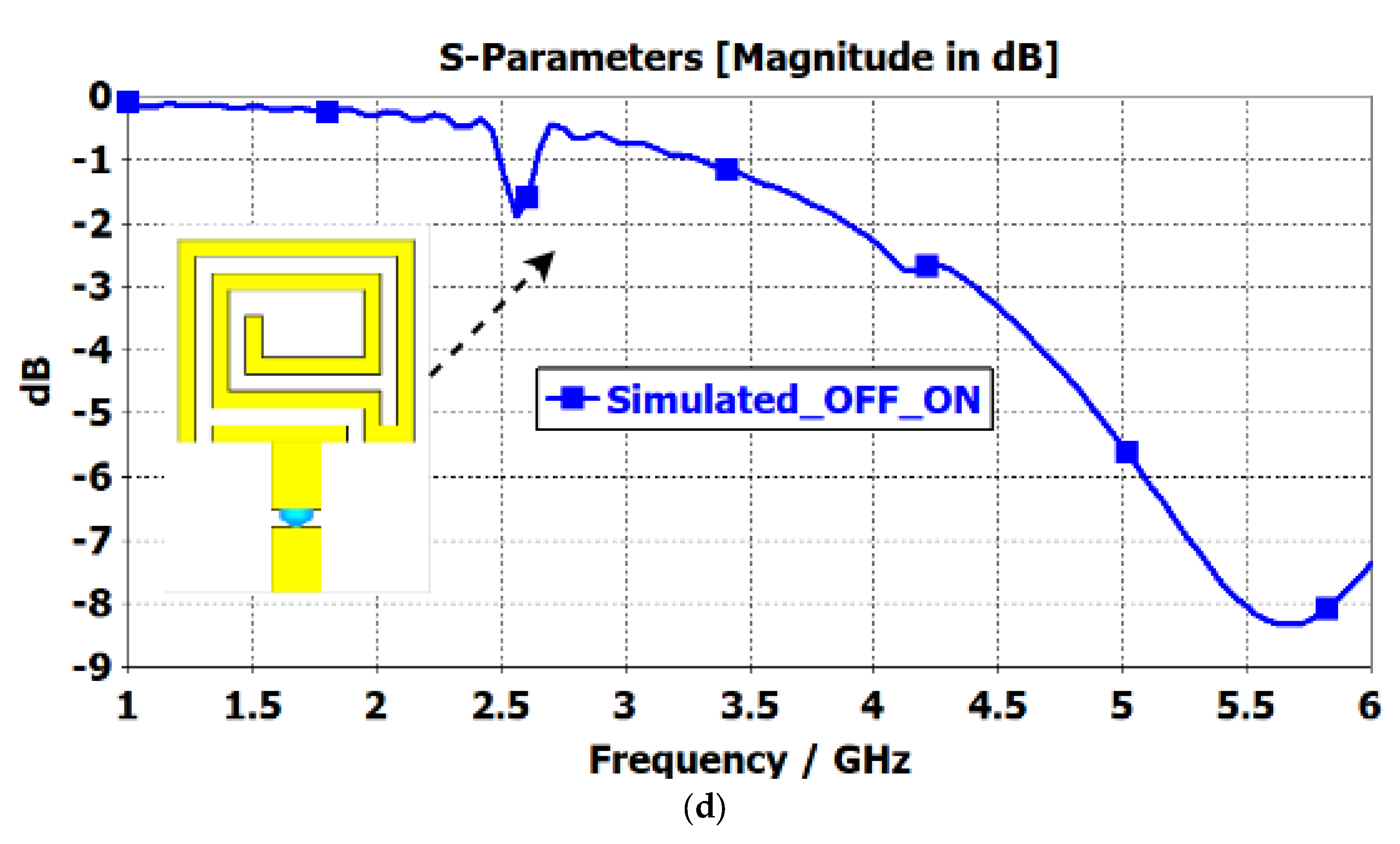
| Dimension Label | Unit (mm) |
|---|---|
| Ws | 16 |
| Wi1 | 10 |
| Wi2 | 8 |
| Wo | 14 |
| g | 1 |
| Ls | 22 |
| Li1 | 8 |
| Lf | 9 |
| Li2 | 6 |
| 3 | |
| Li3 | 3.5 |
| tm | 1 |
| Lo | 12 |
| Lg | 4 |
| 1.6 |
| States | Operating Frequency Range (GHz) | Resonance Frequencies (GHz) | Radiation Efficiency | App. | |
|---|---|---|---|---|---|
| D1 | D2 | ||||
| OFF | OFF | 5.15–5.27 | 5.2 | 50% | Wi-Fi (IEEE 802.11 a/n/ac) Bluetooth (5 GHz) Point-to-point microwave links Short or medium range radar (automotive radar, industrial sensing, radar-based security systems) |
| ON | OFF | 2.14–2.17 | 2.15 | 26% | 3G (UMTS) 4G (LTE) |
| 4.02–4.47 | 4.3 | 87% | wireless backhaul (4G and 5G networks), satellite communication, broadcast systems | ||
| 5.15–5.53 | 5.3 | 82% | WLAN (IEEE 802.11a/n/ac/ax), commercial Wi-Fi | ||
| ON | ON | 2.08–2.11 | 2.09 | 27% | 5G NR (n1 Band), IoT |
| 3.13–3.2 | 3.16 | 74% | |||
| 4.49–5.2 | 4.8 | 88% | Wi-Fi access points (5 GHz) Bluetooth (5 GHz) | ||
| Ref. | Dimension (mm2) | Operational Mode | Reconfigurable Technique (#) | Components Control Method | Frequency Range (GHz) |
|---|---|---|---|---|---|
| [19] | 120 × 60 | Dual-band | Varactor diode (1) | Manually | 1.3–2.6 |
| [20] | 27 × 25 | Single-band, dual-band | PIN diode (3) | Manually | 2.29–2.39, 4.40–4.52, 4.29–4.57, 5.71–5.93, 2.3–2.4, 5.64–5.96 |
| [21] | 50 × 50 | Single-band | PIN diodes (2) | IoT-based NodemCU Unit | 2–5, 2–3.7, 1.8–3.4, 1–3.7 |
| [22] | 25 × 32 | Single-band, Tri-band | Utilizing slots in the radiating patch | Manually | 2.85–5.35, 2.35–2.5, 3.18–3.82, 4.15–5.42 |
| [23] | 70 × 70 | Single-band | Varactor diode (2) | Manually | 2.45–3.55 |
| [25] | 36 × 14 | Single-band | PIN diode (2) | Manually | 2.03–2.17, 2.37–2.51 |
| [26] | 50 × 45 | Dual-band, triple-band | PIN diode (2) | Manually | 2.2–6 |
| [27] | 30 × 28 | Dual- and quad-band | PIN diode (1) | Manually | 1.7–1.9, 2.7–3, 5.7–5.9, 8.8–9.5, 5.6–6.1, 9.3–9.6 |
| [28] | 30 × 30 | Wide-, dual-, and tri-band | PIN diode (2) | Manually | 1.8–4.5 |
| [29] | 48.19 × 38.36 | Single-band | Variable capacitance (6) | Manually | 2.41–5.27 |
| [30] | 33 × 16 | Single and dual-band | PIN diodes (3) | Manually | 2.1–5.2 |
| [31] | 15.5 × 32 | Dual-band single-band | PIN diodes (3) | Microcontroller-based IoT device | 2.01–2.16, 3.189–3.589, 3.13–3.61, 2.97–3.54, 2.81–3.18, 2.59–2.99 |
| This work | 22 × 16 | Broadband or triple-Band | PIN diodes (2) orRF switch (2) | Manually or Arduino | 2.08–5.53 |
Disclaimer/Publisher’s Note: The statements, opinions and data contained in all publications are solely those of the individual author(s) and contributor(s) and not of MDPI and/or the editor(s). MDPI and/or the editor(s) disclaim responsibility for any injury to people or property resulting from any ideas, methods, instructions or products referred to in the content. |
© 2023 by the authors. Licensee MDPI, Basel, Switzerland. This article is an open access article distributed under the terms and conditions of the Creative Commons Attribution (CC BY) license (https://creativecommons.org/licenses/by/4.0/).
Share and Cite
Gençoğlan, D.N.; Çolak, Ş.; Palandöken, M. Spiral-Resonator-Based Frequency Reconfigurable Antenna Design for Sub-6 GHz Applications. Appl. Sci. 2023, 13, 8719. https://doi.org/10.3390/app13158719
Gençoğlan DN, Çolak Ş, Palandöken M. Spiral-Resonator-Based Frequency Reconfigurable Antenna Design for Sub-6 GHz Applications. Applied Sciences. 2023; 13(15):8719. https://doi.org/10.3390/app13158719
Chicago/Turabian StyleGençoğlan, Duygu Nazan, Şule Çolak, and Merih Palandöken. 2023. "Spiral-Resonator-Based Frequency Reconfigurable Antenna Design for Sub-6 GHz Applications" Applied Sciences 13, no. 15: 8719. https://doi.org/10.3390/app13158719
APA StyleGençoğlan, D. N., Çolak, Ş., & Palandöken, M. (2023). Spiral-Resonator-Based Frequency Reconfigurable Antenna Design for Sub-6 GHz Applications. Applied Sciences, 13(15), 8719. https://doi.org/10.3390/app13158719






